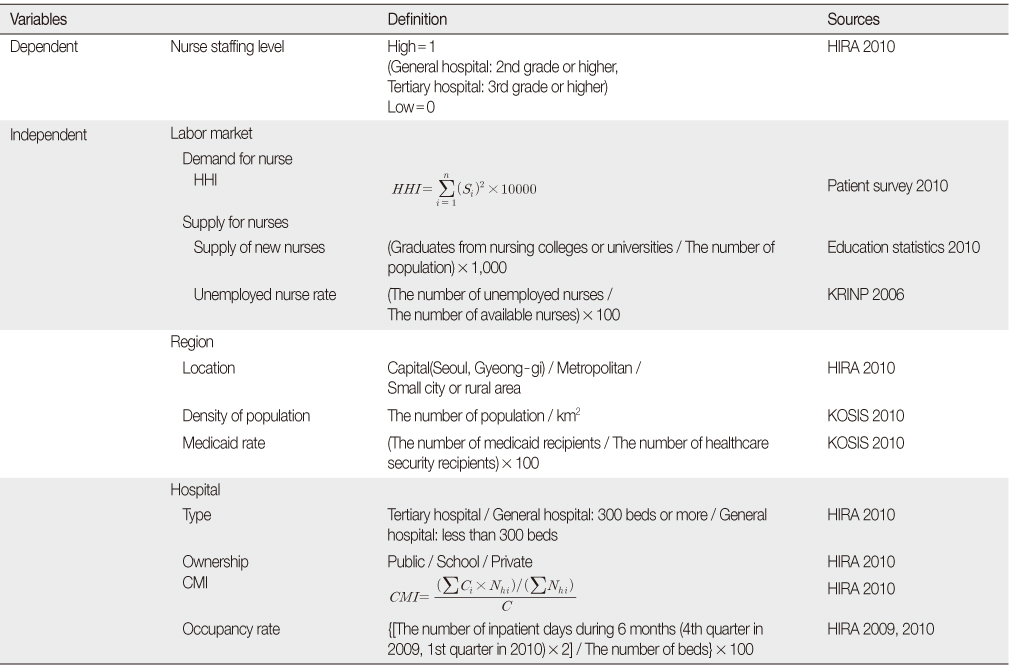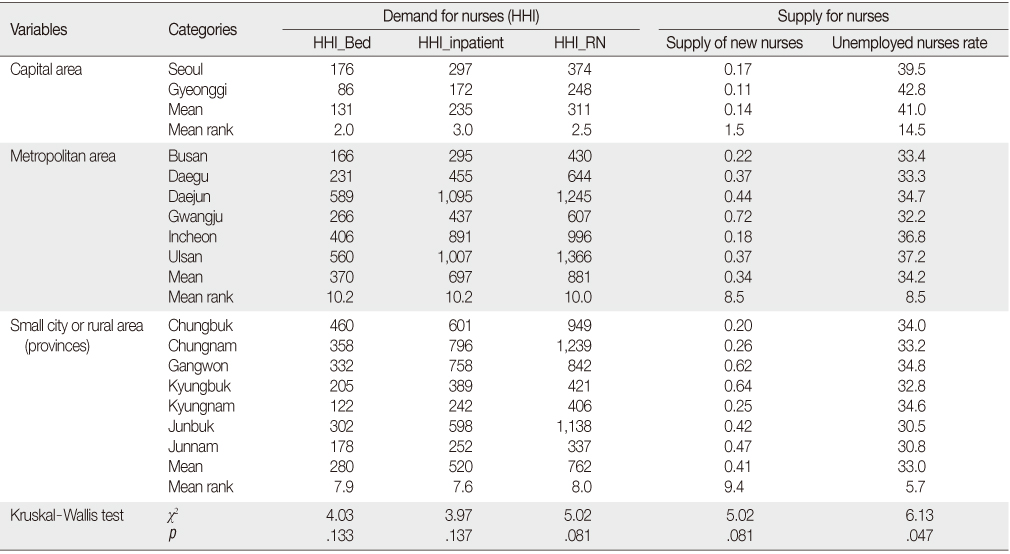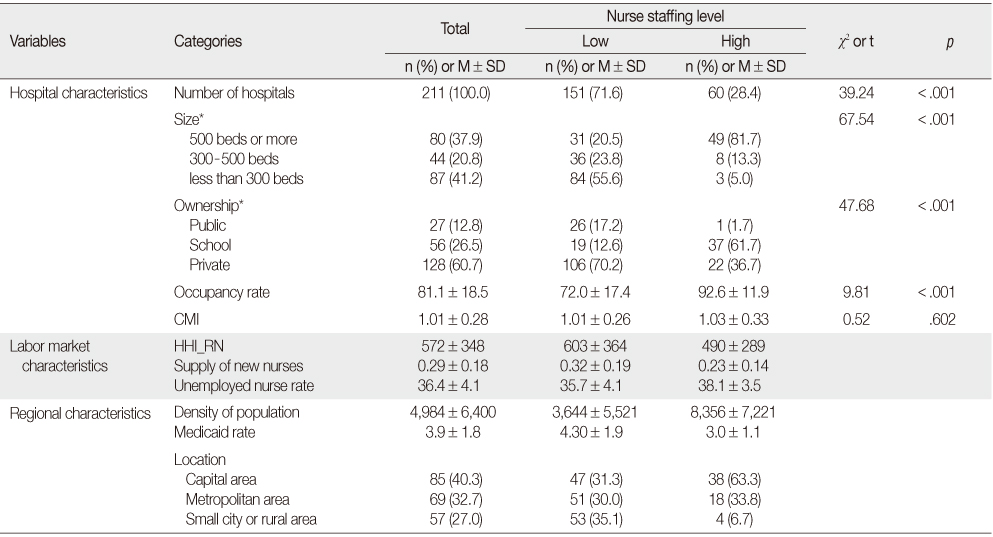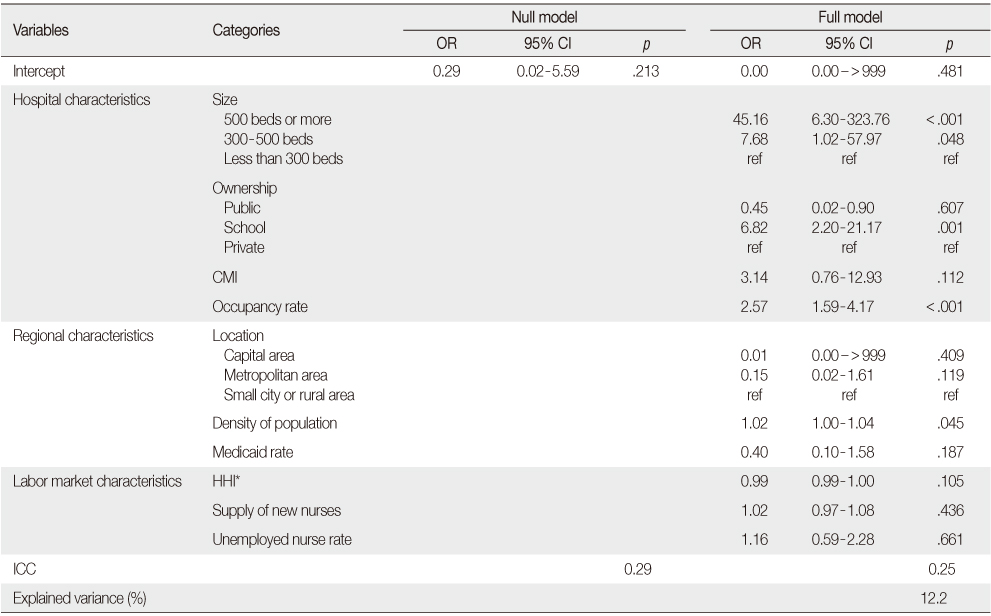Articles
- Page Path
- HOME > J Korean Acad Nurs > Volume 43(1); 2013 > Article
-
Original Article
- Structure of Nurse Labor Market and Determinants of Hospital Nurse Staffing Levels
- Bohyun Park, Sukyung Seo, Taejin Lee
-
Journal of Korean Academy of Nursing 2013;43(1):39-49.
DOI: https://doi.org/10.4040/jkan.2013.43.1.39
Published online: February 28, 2013
1Department of Nursing, Kimcheon Science College, Gimcheon, Korea.
2BK21 Center for Elderly Health Policy Research, Seoul National University, Seoul, Korea.
3Graduate School of Public Health, Seoul National University, Seoul, Korea.
- Address reprint requests to: Lee, Taejin. Graduate School of Public Health, Seoul National University, 1 Gwanak-ro, Gwanak-gu, Seoul 151-742, Korea. Tel: +82-2-880-2726, Fax: +82-2-762-9105, tjlee@snu.ac.kr
© 2013 Korean Society of Nursing Science
Abstract
-
Purpose
- To analyze the structure of Korean nurse labor market and examine its effect on hospital nurse staffing.
-
Methods
- Secondary data were obtained from Statistics Korea, Education Statistics, and Health Insurance Review & Assessment Service and Patient Survey. Intensity of monopsony in the nurse labor market was measured by Herfindahl Hirshman Index (HHI). Hospital nurse staffing level was divided into high and low. While controlling for confounding factors such as inpatient days and severity mix of patients, effects of characteristics of nurse labor markets on nurse staffing levels were examined using multi-level logistic regressions.
-
Results
- For characteristics of nurse labor markets, metropolitan areas had high intensity of monopsony, while the capital area had competitive labor market and the unemployed nurse rate was higher than other areas. Among hospital characteristics, bed occupancy rate was significantly associated with nurse staffing levels. Among characteristics of nurse labor markets, the effect of HHI was indeterminable.
-
Conclusion
- The Korean nurse labor market has different structure between the capital and other metropolitan areas. But the effect of the structure of nurse labor market on nurse staffing levels is indeterminable. Characteristics such as occupancy rate and number of beds are significantly associated with nurse staffing levels. Further study in support of the effect of nurse labor market is needed.
This manuscript is based on a part of the first author's doctoral dissertation from Seoul National University.
This study was supported by the research fund of the Korea Health & Medical Worker's Union in 2011.
- 1. Adamache KW, Sloan FA. Unions and hospitals: Some unresolved issues. J Health Econ. 1982;1(1):81–108.PubMed
- 2. Bhaskar V, Manning A, To T. Oligopsony and monopsonistic competition in labor markets. J Econo Perspect. 2002;16(2):155–174. http://dx.doi.org/10.1257/0895330027300.Article
- 3. Blegen MA, Goode CJ, Reed L. Nurse staffing and patient outcomes. Nurs Res. 1998;47(1):43–50. http://dx.doi.org/10.1097/00006199-199801000-00008.ArticlePubMed
- 4. Blegen MA, Vaughn T, Vojir CP. Nurse staffing levels: Impact of organizational characteristics and registered nurse supply. Health Serv Res. 2008;43(1):154–173. http://dx.doi.org/10.1111/j.1475-6773.2007.00749.x.ArticlePubMedPMC
- 5. Bloom JR, Alexander JA, Nuchols BA. Nurse staffing patterns and hospital efficiency in the United States. Soc Sci Med. 1997;44(2):147–155. http://dx.doi.org/10.1016/S0277-9536(96)00063-9.ArticlePubMed
- 6. Brewer CS, Frazier P. The influence of structure, staff type, and managed-care indicators on registered nurse staffing. J Nurs Adm. 1998;28(9):28–36. http://dx.doi.org/10.1097/00005110-199809000-00007.Article
- 7. Cho SH, June KJ, Kim YM, Park BH. Changes in hospital nurse staffing after implementing differentiated inpatient nursing fees by staffing grades. J Korean Acad Nurs Adm. 2008;14(2):167–175.
- 8. Cho WH. Labor economics: Theory and reform policy. 1999;Paju, Bobmunsa.
- 9. Dickens WT, Lang K. Neoclassical and sociological perspectives on segmented labor markets. 1987;Cambridge, National Bureau of Economic Research.
- 10. Feldman R, Scheffler R. The union impact on hospital wages and fringe benefits. Ind Labor Relat Rev. 1982;35(2):196–206. http://dx.doi.org/10.2307/2522318.ArticlePubMed
- 11. Greene J, Nordhaus-Bike AM. Nurse shortage. Where have all the RNs gone? Hosp Health Netw. 1998;72(15-16):7880.
- 12. Grumbach K, Ash M, Seago JA, Spetz J, Coffman J. Measuring shortages of hospital nurses: How do you know a hospital with a nursing shortage when you see one? Med Care Res Rev. 2001;58(4):387–403. http://dx.doi.org/10.1177/107755870105800401.ArticlePubMedPDF
- 13. Hirsch BT, Schumacher EJ. Classic or new monopsony? Searching for evidence in nursing labor markets. J Health Econ. 2005;24(5):969–989. http://dx.doi.org/10.1016/j.jhealeco.2005.03.006.ArticlePubMed
- 14. Hodge MB, Romano PS, Harvey D, Samuels SJ, Olson VA, Sauvé MJ, et al. Licensed caregiver characteristics and staffing in California acute care hospital units. J Nurs Adm. 2004;34(3):125–133. http://dx.doi.org/10.1097/00005110-200403000-00005.Article
- 15. Jeong HJ, Yang BM. Monopsony power of general hospitals in nurse labor market. Korean J Hosp Manage. 2000;5(2):40–58.
- 16. Kim YM, Cho SH, Jun KJ, Go SH. The effects of institutional and market factors on nurse staffing in acute care hospitals. Korean J Health Policy Adm. 2007;17(2):68–90.Article
- 17. Kim YM, June KJ, Cho SH. Factors related to nurse staffing levels in tertiary and general hospitals. J Korean Acad Nurs. 2005;35(8):1493–1499.ArticlePDF
- 18. Mark BA, Jones CB, Lindley L, Ozcan YA. An examination of technical efficiency, quality, and patient safety in acute care nursing units. Policy Polit Nurs Pract. 2009;10(3):180–186. http://dx.doi.org/10.1177/1527154409346322.ArticlePubMedPMCPDF
- 19. Miller RA. The herfindahl-hirschman index as a market structure variable: An exposition for antitrust practitioners. Antitrust Bull. 1982;27(3):593–618.ArticlePDF
- 20. Ministry of Health & Welfare. OECD health data. 2008;Retrieved May 2, 2008. from http://stat.mw.go.kr/front/statData/publicationView.jsp?menuId=43&bbsSeq=9&nttSeq=13157&searchKey=&searchWord=&nPage=2.
- 21. Mullner R, Beyers M, Levy P, Byre C, Mallin K. Community hospital characteristics associated with RN and LPN vacancy rates. Soc Sci Med. 1983;17(15):1055–1059. http://dx.doi.org/10.1016/027 7-9536(83)90411-2.ArticlePubMed
- 22. Oh YH. Distributional change in major health manpower in Korea, 2000-2006. Health Welf Policy Forum. 2008;139:98–110.
- 23. Peterson CA. Nursing shortage: Not a simple problem-no easy answers. Online J Issues Nurs. 2001;6(1):1.
- 24. Robinson JC. Market structure, employment, and skill mix in the hospital industry. South Econ J. 1988;55(2):315–325. http://dx.doi.org/10.2307/1059105.Article
- 25. Seago JA, Ash M, Spetz J, Coffman J, Grumbach K. Hospital registered nurse shortages: Environmental, patient, and institutional predictors. Health Serv Res. 2001;36(5):831–852.PubMedPMC
- 26. Staiger DO, Spetz J, Phibbs CS. Is there monopsony in the labor market? Evidence form a natural experiment. J Labor Econ. 2010;28(2):211–236.
- 27. Sullivan D. Monopsony power in the market for nurses. J Law Econ. 1989;32(2):S135–S179. http://dx.doi.org/10.1086/467192.Article
- 28. Yett DE. An analysis of the causes and consequences of salary differentials in nursing. Econ Inq. 1966;5(1):103. http://dx.doi.org/10.1111/j.1465-7295.1966.tb01990.x.Article
REFERENCES
Figure & Data
REFERENCES
Citations

- Empirical Analysis of Geographic Inequalities in the Distribution of Nurses
Euntae Park, Jinhyun Kim
Journal of Korean Academy of Nursing Administration.2024; 30(3): 271. CrossRef - The Number of Practicing Nurses Required to Resolve Differences in Staffing Levels between Capital and Non-capital Regions and the Relationship of Regional Differences in Staffing and Salary
Sung-Hyun Cho, Ji-Yun Lee, Jinhyun Kim, U Ri Go, Jiyeong Seong
Journal of Korean Academy of Nursing Administration.2024; 30(2): 175. CrossRef - Nurses’ Intentions for COVID-19 Vaccination in South Korea in 2022
Byung Yun Song, Sun Hee Choi, Dong Yeon Kim
Journal of Korean Academy of Fundamentals of Nursing.2023; 30(1): 125. CrossRef - Integrative literature review of patient classification tools for nursing intensity evaluation: Focusing on comparison of South Korean and international tools
Yukyung Ko, Bohyun Park
Nursing Open.2021; 8(5): 2105. CrossRef - Turnover Rates and Factors Influencing Turnover of Korean Acute Care Hospital Nurses: A Retrospective Study Based on Survival Analysis
Bohyun Park, Yukyung Ko
Asian Nursing Research.2020; 14(5): 293. CrossRef - Geographic Mobility and Related Factors among Newly Graduated Nurses
Hyo Jeong Yoon, Sung Hyun Cho
Journal of Korean Academic Society of Nursing Education.2017; 23(3): 353. CrossRef - Patterns and Influential Factors of Inter-Regional Migration of New and Experienced Nurses in 2011~2015
Bohyun Park, Se Young Kim
Journal of Korean Academy of Nursing.2017; 47(5): 676. CrossRef - Influences of Burnout, Emotional labor, and Positive Psychological Capital on Job Satisfaction of Nurses
Soo Young Jun
Journal of Korean Academy of Nursing Administration.2017; 23(2): 201. CrossRef - Narrative Exploration of Infertile Nurses' Experience of Natural Abortion
Ju-Eun Hong, Jum-Mi Park
Journal of Korean Academy of Psychiatric and Mental Health Nursing.2016; 25(1): 58. CrossRef - Factors influencing the intent to return to practice (work) of inactive RNs
Nami Hwang, Insun Jang, Eunjun Park
Journal of the Korean Data and Information Science Society.2016; 27(3): 791. CrossRef - Hospital preferences of nursing students in Korea: a discrete choice experiment approach
Bo-hyun Park, YuKyung Ko
Human Resources for Health.2016;[Epub] CrossRef - A Path Analysis of Variables Influencing customer orientation of Hospital Nurses
Eun-Su Do, Young-Sook Seo
Journal of Digital Convergence.2016; 14(1): 275. CrossRef - Impact of a financial incentive policy on Korean nurse staffing
Y. Kim, J. Kim
International Nursing Review.2015; 62(2): 171. CrossRef - Study on Factors Associated with the Rise in Grade of Nursing Management Fee among Korean Hospitals
Hyun-Min Choi, Nam-Kyung Han, Sang-Kyu Lee, Han-Sung Kim, Sungkyoung Choi, Woojin Chung
Health Policy and Management.2015; 25(1): 40. CrossRef - Mediation Effect of Nursing Competency between Transformational Leadership and Organizational Commitment of Nurses in Hospitals
Young-Sook Seo, Yu-Lim Son, Chu-Young Jung
Journal of Korean Clinical Health Science.2015; 3(3): 419. CrossRef - Issues and Challenges of Nurse Workforce Policy: A Critical Review and Implication
Taewha Lee, Kyeong Hwa Kang, Yu Kyung Ko, Sung-Hyun Cho, Eun-Young Kim
Journal of Korean Academy of Nursing Administration.2014; 20(1): 106. CrossRef
Definition of Variables and Data Sources
Note: Capitalize all of the above names.
HIRA=Healthcare insurance review & assessment service; HHI=Herfindahl Hirshman index; KRINP=The Korean research institute for nursing policy; KOSIS=Korean statistical information service; CMI=Case mix index.
Demand and Supply for Nurses by Region
HHI=Herfindahl Hirshman index; RN=Registered nurse.
Wage of Nurses by Hospital Characteristics
*10,000 won/year; **Duncan grouping: a>b, c>d; †General hospital: 1st-2nd grade, Tertiary hospital: 3rd grade or higher; ‡General hospital: 3rd-5th grade, Tertiary hospital: 4-6th grade.
Hospital and Environmental Characteristics by Nurse Staffing Level
*Fisher's exact test; CMI=Case mix index; HHI=Herfindahl Hirshman index; RN=Registered nurse.
Determinants of Hospital Nurse Staffing Levels (Dependent variable: High nurse grade)
OR=Odds ratio; CMI=Case mix index; HHI=Herfindahl Hirshman index; ICC=Intraclass correlation.
*HHI was calculated on the basis of hospital's nurse share in their labor market(HHI_RN).
Note: Capitalize all of the above names. HIRA=Healthcare insurance review & assessment service; HHI=Herfindahl Hirshman index; KRINP=The Korean research institute for nursing policy; KOSIS=Korean statistical information service; CMI=Case mix index.
HHI=Herfindahl Hirshman index; RN=Registered nurse.
*10,000 won/year; **Duncan grouping: a>b, c>d; †General hospital: 1st-2nd grade, Tertiary hospital: 3rd grade or higher; ‡General hospital: 3rd-5th grade, Tertiary hospital: 4-6th grade.
*Fisher's exact test; CMI=Case mix index; HHI=Herfindahl Hirshman index; RN=Registered nurse.
OR=Odds ratio; CMI=Case mix index; HHI=Herfindahl Hirshman index; ICC=Intraclass correlation. *HHI was calculated on the basis of hospital's nurse share in their labor market(HHI_RN).
 KSNS
KSNS
 E-SUBMISSION
E-SUBMISSION





 Cite
Cite

